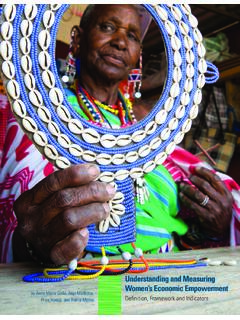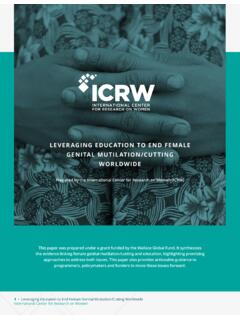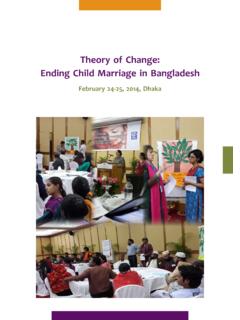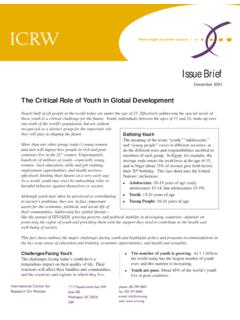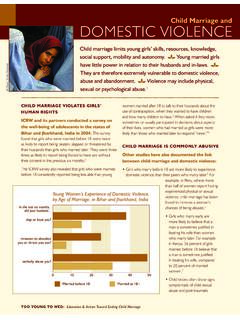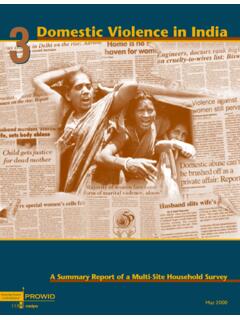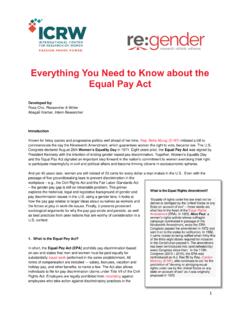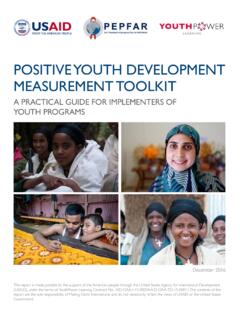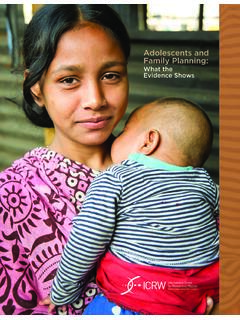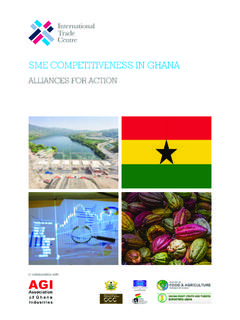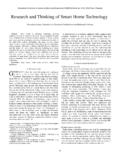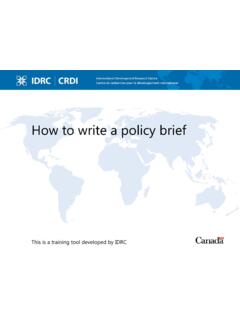Transcription of Domestic Violence in India - International Center for ...
1 A Summary Report of Three StudiesSeptember 199911 Domestic Violence in IndiaCopyright 1999 International Center for Research on Women and The Centre for Development and Population ActivitiesViolence against Women in India :Evidence from Rural GujaratLeela VisariaGujarat Institute of Development StudiesBest Practices among Responsesto Domestic Violence inMaharashtra and Madhya PradeshNishi MitraWomen s Studies UnitTata Institute of Social Sciences, MumbaiResponses to Domestic Violencein Karnataka and GujaratVeena Poonacha and Divya PandeyResearch Centre for Women s Studies (RCWS),and SNDT Women s University, MumbaiDomestic Violencein IndiaA Summary Report ofThree StudiesINTERNATIONAL Center FOR RESEARCH ON WOMENW ashington, DCFunded by USAID/IndiaSeptember 1999 PrefaceThe International Center for Research on Women (ICRW), in collaboration with Indian researchers, is pleasedto present the first in a series summarizing the research studies being undertaken in India on domesticviolence against women.
2 The summary reports presented in this volume have been prepared by the ICRW team comprised of Barbara Burton, Nata Duvvury, Anuradha Rajan, and Nisha Varia in consultation withthe individual research teams. The Introduction and Conclusions have been written by the ICRW team synthe-sizing findings across the three studies. The ICRW team takes full responsibility for any errors or omissions. Theinterpretations of findings in the full report do not necessarily reflect the opinions of the individual ICRW team wishes to acknowledge the incisive comments by Geeta Rao Gupta and Jacquelyn Campbellon the draft of this report. The excellent editorial support by Charlotte Feldman-Jacobs and the unstintingadministrative support by Miriam Escobar are gratefully DuvvuryProject DirectorContentsIntroduction1 Violence against Women in India :Evidence from Rural Gujarat9 Leela VisariaGujarat Institute of Development StudiesBest Practices among Responses to Domestic Violencein Maharashtra and Madhya Pradesh18 Nishi MitraWomen s Studies UnitTata Institute of Social Sciences, MumbaiResponses to Domestic Violence in Karnataka and Gujarat28 Veena Poonacha and Divya PandeyResearch Centre for Women s Studies (RCWS),And SNDT Women s University, MumbaiConclusion42 Bibliography49 This publication was made possible through support provided by the Office of Women in Development, GlobalBureau, the United States Agency for International Development (USAID) under the terms of Cooperative AgreementNo.
3 FAO-A-00-95-00030-00. The opinions expressed herein do not necessarily reflect the views of The research program in India is part of the larger global grants program called Promoting Women in Development (PROWID) beingimplemented by ICRW in partnership with CEDPA and funded by International Center for Research on Women(ICRW) is conducting a three-year research pro-gram, which began in 1997, on Domestic Violence inIndia in partnership with researchers from a range ofIndian academic and activist A Na-tional Advisory Council, representing the differentconstituencies in India that address the issue, pro-vides guidance for the program. The goal of theprogram is to provide reliable and sound informa-tion with which to identify, replicate, expand, andadvocate for effective responses to Domestic program has three components: first, assessingpatterns and trends of Domestic Violence by identify-ing and analyzing existing data sets; second, con-ducting population-based surveys to estimate preva-lence and to increase the understanding of determi-nants and outcomes of Domestic Violence ; and third,distilling lessons learned from an analysis of on-go-ing programmatic and policy interventions.
4 [All ofthe individual studies supported through this researchprogram are briefly summarized in Box 1]. In thisvolume, we present summary reports of the first threestudies to be completed. The first is a householdstudy by Leela Visaria that enumerates and elucidatestrends of Domestic Violence in rural Gujarat and pro-vides a backdrop to the intervention studies. Theother two studies, one by Nishi Mitra and the otherby Veena Poonacha and Divya Pandey, document andanalyze the range of organized responses to domes-tic Violence against women being implemented bythe state and non-governmental sectors in India andare hereafter referred to as the response studies. Domestic Violence : A Public IssueAccording to available statistics from around theglobe, one out of every three women has experiencedviolence in an intimate relationship at some point inher life. This is an average based on available na-tional surveys across industrialized and developingcountries (World Health Organization 1997).
5 Statisti-cal evidence on the actual prevalence of domesticviolence in India is scant however. The few studiesavailable indicate that physical abuse of Indian womenis quite high, ranging from 22 percent to 60 percentof women surveyed (Rao 1996 and Mahajan 1990).Most of the available information consists of qualita-tive studies of very small sample size. The only large-scale indicator of Violence against women is the datarelating to crimes against women published by theNational Crimes Record Bureau, Ministry of HomeAffairs, Government of India . The records of the bu-reau reveal a shocking percent increase in casesof torture and dowry deaths during the period from1991 to 1995 and may reflect increased reporting ofviolence. In 1995, torture of women constituted of all reported crimes against women. In an-other study, 18 to 45 percent of married men in fivedistricts of Uttar Pradesh, a large state in northernIndia, acknowledged that they physically abused theirwives (Narayana 1996).
6 And in a study by RanjanaIntroduction2 Domestic Violence in India : A Summary ReportAn Analysis of Primary Survey Data from GujaratLeela Visaria, Gujarat Institute of Development Studies, population-based study presents a picture of Domestic Violence as reported by 346 married women in ruralGujarat. Through both quantitative and qualitative methods, this project explores the magnitude and correlates ofviolence; forms and reasons given for Violence ; and women s options for Analysis of Hospital Records in Thane District, MaharashtraSurinder Jaswal, Tata Institute of Social Sciences (TISS), study examines the records of hospitals and community health outposts in Thane District. The project studiesthe construction of the definition of Violence by both the community and the providers of care as well as recon-structing specific incidents of Violence through in-depth Analysis of Records of Special Cell for Women and Children Located in the Police Commissioner sOffice in MumbaiAnjali Dave and Gopika Solanki, Tata Institute of Social Sciences (TISS), study analyzes the records of Mumbai s Special Cell, a collaboration between the police and the Tata Institute ofSocial Science.
7 The project addresses how the language used in recording cases influences the investigativeprocess and the final resolution of the Analysis of Records of NGOs in BangaloreSandhya Rao, Hengasara Hakkina Sangha, the records of non-governmental organizations in Bangalore, this study explores Domestic Violence as ahuman rights issue. Included in the sample are a feminist organization working on Violence issues for the lasttwenty years and a shelter which was established in the Analysis of Court Records in Bangalore District Elizabeth, National Law School, University of India , study examines the records of a family court in Bangalore, three district level courts, and the High Court. Theproject examines cases to understand the judicial interpretation of existing laws that have an impact on domesticviolence and to identify the gaps in investigative procedures that result in Population-Based Survey of Domestic ViolenceInternational Clinical Epidemiologists Network (INCLEN).
8 This multi-site study is being conducted by local researchers in seven sites: Lucknow, Bhopal, Delhi, Nagpur,Chennai, Vellore, and Thiruvanathapuram. The project explores the magnitude of Violence , risk and protectivefactors, and health and economic outcomes. The methodology addresses ethical, safety, and training issuesinvolving survey respondents and to Domestic Violence in the States of Gujarat and KarnatakaDivya Pandey and Veena Poonachana, SNDT Women s University, study examines state, collaborative, NGO, and community-based initiatives addressing Domestic Violence inGujarat and to Domestic Violence in the States of Maharashtra and Madhya PradeshNishi Mitra, Tata Institute of Social Sciences (TISS), study examines state, collaborative, NGO, and community-based initiatives addressing Domestic Violence inMaharashtra and Madhya 1 Program Descriptions3 Introduction2 These documents culminated from the 1993 United Nations World Conference on Human Rights in Vienna and the 1995 Fourth WorldConference on Women in (1989) of dowry abuse it was revealed thatone out of every four dowry victims was driven , Violence within the home is universal acrossculture, religion, class, and ethnicity.
9 Despite thiswidespread prevalence, however, such Violence is notcustomarily acknowledged and has remained invis-ible a problem thought unworthy of legal or politi-cal attention. The social construction of the dividebetween public and private underlies the hidden na-ture of Domestic Violence against women. Legal ju-risprudence has historically considered the domainof the house to be within the control and unques-tionable authority of the male head of , acts of Violence against members of the house-hold, whether wife or child, were perceived as disci-pline, essential for maintaining the rule of authoritywithin the family. In the last two decades, the Indian women s move-ment has contributed to a growing public awarenessof Violence against women. Women activists havemobilized and pressed for significant changes in thecriminal code and police procedures in order to ad-dress various acts of Violence . For example, through-out the 1980s, Indian society witnessed numerousprotests by women s organizations against dowrydeaths, custodial rape, abductions of women, sati (theburning of a widow on the funeral pyre), amniocen-tesis used for sex selection of children, sexual harass-ment of young girls and women in public places, traf-ficking, and is unmistakable about these campaigns is thatthey often have focused on those acts of violencethat either occurred in or had impact upon the pub-lic space.
10 Thus, while the subordination of womenin the private sphere was the implicit theoreticalframework for many of the activists, the public-pri-vate divide still continued in practice. State responsesto Violence such as passing the amendment 498A tothe Dowry Act of 1983 (discussed further in NishiMitra s report to follow), establishing All Women Po-lice Stations, or setting up family counseling cells,marked the beginning of attempts to provide someoptions outside the family to women facing domes-tic Violence . However, except for sensational cases,the insidious everyday Violence experienced by hugenumbers of women has remained hidden in the pri-vate several International conventions, there has nowbeen explicit acknowledgment of the state s respon-sibility for human rights violations by private actorsin both the public and private spheres. The ViennaAccord of 1993 and the Beijing Platform of 1995 to-gether crystallized the principle that women s rightsare human The frameworks that these con-ventions established have created a space in whichonce private issues like Domestic Violence can be un-derstood as human rights violations of public con-cern.
